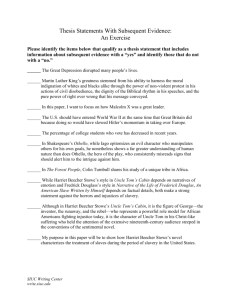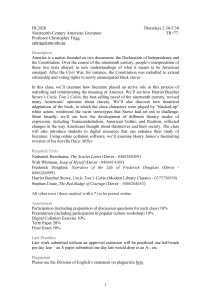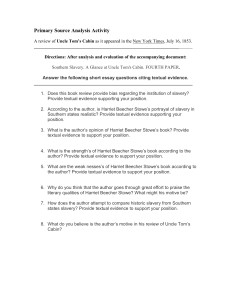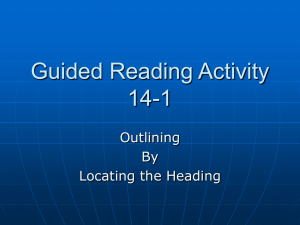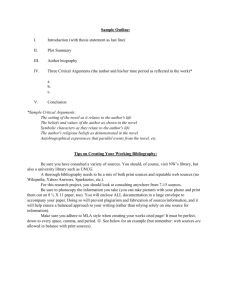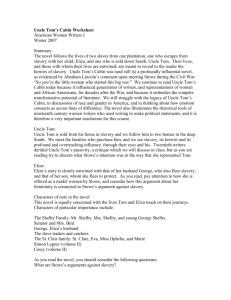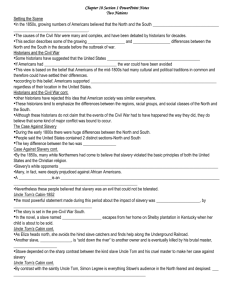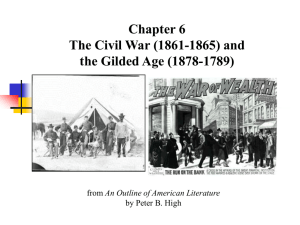Uncle Tom's Failure - The Gilder Lehrman Institute of American History
advertisement
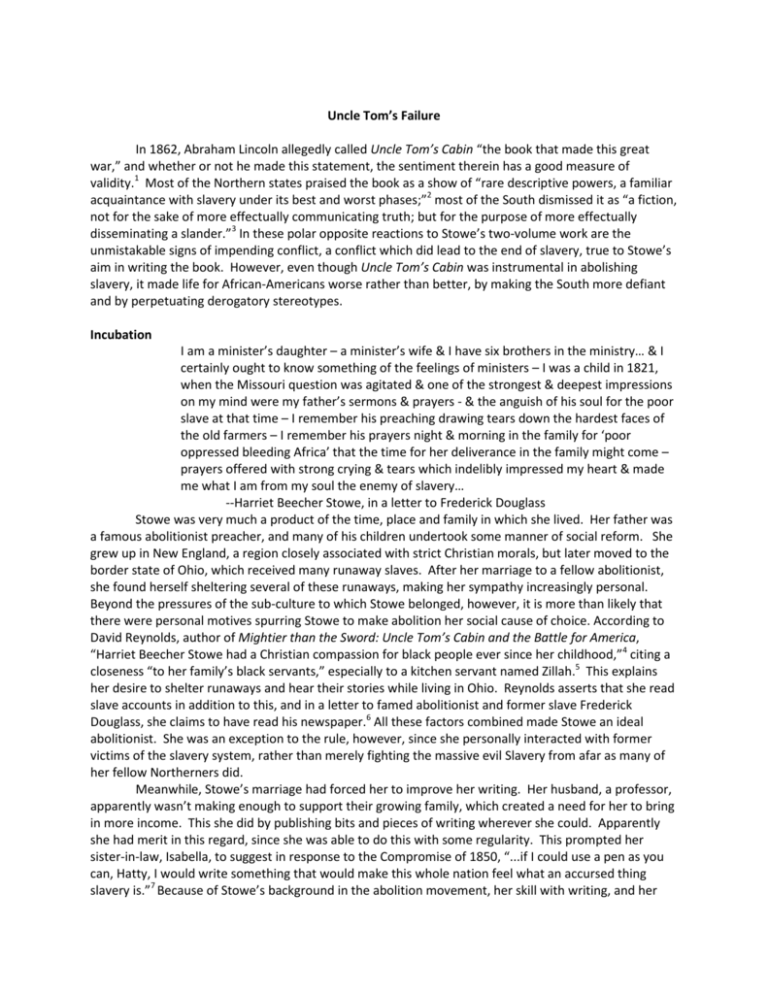
Uncle Tom’s Failure In 1862, Abraham Lincoln allegedly called Uncle Tom’s Cabin “the book that made this great war,” and whether or not he made this statement, the sentiment therein has a good measure of validity.1 Most of the Northern states praised the book as a show of “rare descriptive powers, a familiar acquaintance with slavery under its best and worst phases;”2 most of the South dismissed it as “a fiction, not for the sake of more effectually communicating truth; but for the purpose of more effectually disseminating a slander.”3 In these polar opposite reactions to Stowe’s two-volume work are the unmistakable signs of impending conflict, a conflict which did lead to the end of slavery, true to Stowe’s aim in writing the book. However, even though Uncle Tom’s Cabin was instrumental in abolishing slavery, it made life for African-Americans worse rather than better, by making the South more defiant and by perpetuating derogatory stereotypes. Incubation I am a minister’s daughter – a minister’s wife & I have six brothers in the ministry… & I certainly ought to know something of the feelings of ministers – I was a child in 1821, when the Missouri question was agitated & one of the strongest & deepest impressions on my mind were my father’s sermons & prayers - & the anguish of his soul for the poor slave at that time – I remember his preaching drawing tears down the hardest faces of the old farmers – I remember his prayers night & morning in the family for ‘poor oppressed bleeding Africa’ that the time for her deliverance in the family might come – prayers offered with strong crying & tears which indelibly impressed my heart & made me what I am from my soul the enemy of slavery… --Harriet Beecher Stowe, in a letter to Frederick Douglass Stowe was very much a product of the time, place and family in which she lived. Her father was a famous abolitionist preacher, and many of his children undertook some manner of social reform. She grew up in New England, a region closely associated with strict Christian morals, but later moved to the border state of Ohio, which received many runaway slaves. After her marriage to a fellow abolitionist, she found herself sheltering several of these runaways, making her sympathy increasingly personal. Beyond the pressures of the sub-culture to which Stowe belonged, however, it is more than likely that there were personal motives spurring Stowe to make abolition her social cause of choice. According to David Reynolds, author of Mightier than the Sword: Uncle Tom’s Cabin and the Battle for America, “Harriet Beecher Stowe had a Christian compassion for black people ever since her childhood,”4 citing a closeness “to her family’s black servants,” especially to a kitchen servant named Zillah.5 This explains her desire to shelter runaways and hear their stories while living in Ohio. Reynolds asserts that she read slave accounts in addition to this, and in a letter to famed abolitionist and former slave Frederick Douglass, she claims to have read his newspaper.6 All these factors combined made Stowe an ideal abolitionist. She was an exception to the rule, however, since she personally interacted with former victims of the slavery system, rather than merely fighting the massive evil Slavery from afar as many of her fellow Northerners did. Meanwhile, Stowe’s marriage had forced her to improve her writing. Her husband, a professor, apparently wasn’t making enough to support their growing family, which created a need for her to bring in more income. This she did by publishing bits and pieces of writing wherever she could. Apparently she had merit in this regard, since she was able to do this with some regularity. This prompted her sister-in-law, Isabella, to suggest in response to the Compromise of 1850, “...if I could use a pen as you can, Hatty, I would write something that would make this whole nation feel what an accursed thing slavery is.”7 Because of Stowe’s background in the abolition movement, her skill with writing, and her proximity to a slave state, she was the perfect candidate for writing a book to make slavery more real and personal. Such a book would aim at Northern citizens who were numbed by distance, and at the South, to humanize what they often saw as mere property to recover. And in many ways this was the perfect time: Reynolds cites two different wildly popular writing styles of this period, sensational and sentimental, the names of which being somewhat self-explanatory. The sensational is all about excitement and action, whereas the sentimental is aimed directly at the heart-strings. Reynolds logically claims that by combining these two different common approaches in literature of the time, Stowe had a sure-fire crowd pleaser for readers of that time.8 Other seldom mentioned elements that would increase the book’s popularity were the inclusion of caricatures, which had already gained popularity in the North thanks to minstrel shows.9 These included Sambo, the “happy black;” Zip Coon, the free black trying and failing to imitate whites; Mammy, the large, loyal and somewhat masculine female slave; and the pickaninny, the savage-like, dirty black child.10 Sambo and Coon especially were used as comic relief, but their main purpose was as “a double-edged defense of slavery—Zip Coon, proof of blacks’ ludicrous failure to adapt to freedom, and Sambo, the fantasy of happy darkies in their proper place.”11 In bizarre irony, though Stowe’s purpose was to attack rather than defend the slavery system, she incorporates each of these stereotypes. A slave of Uncle Tom’s first owner, named Sam, is the greatest source of comic relief and, by his fondness for using and misusing high-flown language, is clearly modeled after the Coon, although some traces of Sambo are present in his overly happy behavior12. Another slave named Adolph on St. Clare’s plantation, who wears his master’s old clothes and puts on the airs to match, also belongs in the Coon category.13 It is not hard to find the Mammy caricature in the book, as the beloved caretaker of Marie and Eva St. Clare retains the name.14 And Topsy, among the most famous characters of the book, is clearly a representative of the pickaninny stereotype15. It is difficult to say whether Stowe used these stereotypes intentionally for appeal to her Northern audience, who would already know and love them from minstrel shows, or if she herself believed them to be true out of lack of experience of actual slaves on plantations. This highlights the one glaring factor rendering Stowe less than ideal for writing an expose on slavery in the South—that she was not experienced in the life of the South. The extent of her stay in an actual slave state was in Kentucky for a mere few days, and this forced her to rely on research. According to J. C. Furnas’ Goodbye to Uncle Tom, “she herself admitted [that Kentucky] was not at all representative of the Deep South, where her story was concentrated.”16 Other than this she relied on information from Douglass and abolitionist propaganda; though this propaganda and research was somewhat reliable, “by any modern standards she utterly lacked direct knowledge for [the plot concerning Uncle Tom in the Deep South] and, for [the plot regarding a runaway mulatto couple] had adequate background on only the Underground Railroad episodes.”17 Furnas goes on to elaborate that making up a little bit to fill in details on a location to which one hasn’t been is generally acceptable, “but descriptions of whole social groups and situations that depend for their interest on their claim to be well grounded, whether admittedly fictional or not, can be vicious when those claims are false. Creative license is no excuse in the novel-with-a-purpose.”18 Apparently Stowe was desperate to get her book published right away, despite her lack of knowledge, since she believed that her book would help her divided country toward abolition in peace, not war.19 This is supported by Stowe’s pleas in her final chapter “to you, generous, noble-minded men and women, of the South—you, whose virtue and magnanimity, and purity of character, are the greater for the severer trial it has encountered,”20 and to the North, who “have something more to do than denounce their brethren at the South; they have to look to the evil among themselves.”21 And so her book, directed at both the North and South, detailing the Christ-like life and death of the slave Uncle Tom, was serialized in 1851 and published in 1852. Reception Its object is to abolish slavery. Its effect will be to render slavery more difficult than ever of abolishment. Its popularity constitutes its greatest difficulty. It will keep ill-blood at boiling-point, and irritate instead of pacifying those whose proceedings Mrs. STOWE is anxious to influence on behalf of humanity. ‘Uncle Tom's Cabin’ was not required to convince the haters of slavery of the abomination of the ‘institution;’ of all books, it is the least calculated to weigh with those whose prejudices in favor of slavery have yet to be overcome, and whose interests are involved in the perpetuation of the system. If slavery is to cease in America, and if the people of the United States, who fought and bled for their liberty and nobly won it, are to remove the disgrace that attaches to them for forging chains for others which they will not tolerate on their own limbs, the work of enfranchisement must be a movement, not forced upon slaveowners, but voluntarily undertaken, accepted and carried out by the whole community. –Unsigned London Times review of Uncle Tom’s Cabin Generally when historical text mentions Uncle Tom’s Cabin, the word “success” is close by. This word is indeed applicable to the book’s results—in the North. Therein lies the book’s failure. Among abolitionists, it was received joyfully: Frederick Douglass’ newspaper described it as “in its line, the wonder of wonders,”22 and in famed abolitionist William Lloyd Garrison’s paper the review states, “The effect of such a work upon all intelligent and humane minds coming in contact with it, and especially upon the rising generation in its plastic condition, to awaken the strongest compassion for the oppressed and the utmost abhorrence of the system which grinds them to the dust, cannot be estimated: it must be prodigious.”23 Among the few real faults found with the book are with the title character himself. The former review describes him as having “too much piety.”24 The latter cites a double standard—that blacks should turn the other cheek in response to abuse, yet for whites violence is perfectly acceptable.25 This is likely in response to a scene in which George Harris, described as appearing nearly white, receives commendation from the narrator for violently claiming freedom,26 while Tom remains in slavery even when given ample opportunity to leave.27 Sadly, here are the beginnings of the racist ‘Uncle Tom’ stereotype, the image of a black overly submissive to whites, that arose as a result of this book, even in the North. This Uncle Tom stereotype came in addition to the other stereotypes already popular in the North. And, thanks to the lax copyright laws of the day, which allowed derivative works of a copyrighted item without the author’s permission, “Uncle Tom shows” were soon appearing all over, although loyalty to the original was questionable. At first these stagings retained the plot and themes fairly well, as Reynolds cites Nassau William Senior as saying that in the North, “night after night audiences applauded scenes that had a strong antislavery message.”28 Yet in the North, minstrel shows, which had sprung from Jim Crow performances, enjoyed great popularity,29 and it wouldn’t be long before stage adaptations of Uncle Tom’s Cabin and minstrel shows combined in ultimate mockery using racist stereotypes. As for Southern response to the book, a picture really is worth a thousand words: Figure 1 All hell has quite literally broken loose in this picture, captioned “A Dream Caused by the Perusal of Mrs. H. Beecher Stowe’s Popular Work Uncle Tom’s Cabin”. The Library of Congress summary lends some explanation to this “chaotic, nightmarish” picture: In the center a leering black man dressed as a Quaker holds a flag ‘Women of England To The Rescue.’ To the left, near the mouth of a cave marked ‘Underground Railway,’ Mrs. Stowe is pulled and harassed by demons. She holds up a book that reads, ‘Uncle Tom's Cabin, I Love the Blacks.’ Another woman (or perhaps Mrs. Stowe again) rides in a parade of demons on the right. In the distance, several monsters feed copies of ‘Uncle Tom's Cabin’ to a blazing fire.30 The detail about the “Women of England” could possibly cite the book’s popularity in England, which had already banned slavery. As for interpreting the picture as a whole, it could refer to the Southern belief that an attack on slavery was rather an attack on a God-given institution, thus earning His wrath. It could also reflect the sentiment that Northern demons were attacking the South itself with its criticism of the South’s very foundation. Northerners felt justified in denunciation of what they considered an evil institution, but it is difficult to blame the South for feeling victimized by these attacks that did not provide many plausible alternatives to slavery. Newspaper reviews from the Southern Literary Messenger and the Southern Quarterly Review take a much less macabre, Inferno-esque manner of criticizing Stowe’s work. The main point of contention is the aforementioned lack of research. This cost Stowe an entire half of her intended audience and hindered the effective fulfillment of her goal. The Southern Literary Messenger, in two different reviews, takes great pains to dissect the events of Stowe’s novel. They both compare what she insists is legal with what the law actually states. They also select some details from the book to highlight what readers of the review would simply know to be untrue from experience of Southern culture. Among these, according to the Messenger review attributed to John R. Thompson, are the improbable initial sale of Tom, and the witnessed beating to death of a slave, which Thompson calls illegal in stark contrast to Stowe’s insistence that it’s “within the law.”31 Louisa S. McCord of the Southern Quarterly goes beyond this to mock the false dialects/mannerisms of supposedly Southern characters.32 Regardless of whether or not events that Stowe includes in the novel would occur, as Louisa S. McCord of Louisiana put it, “we deny that it is ‘the artist's privilege’ to cull out the most horrible exceptional cases, and to represent them as forming the manners and habits of a whole people, vouching for them as fac simile representations of real life.”33 Stowe’s passionate tone in the novel caused “the frequent moistening of our eyes, and the making of our heart grow liquid as water, and the trembling of every nerve within us, in the perusal of the incidents and scenes so vividly depicted in her pages,”34 to Northerners. But this same tone made her a laughingstock in the South, and thereby ruined her chances of gaining any desirable response from this group. All the pathos in the world cannot make a difference without logic and credibility, which to McCord she greatly lacks: “The authoress is so ignorant of Southern life and slave institutions, that she does not know how very far she leaves behind her, the track of probability, and her vouchers of the Westminster [a Northern review that favored the book], might, perhaps, if induced to reconsider the matter, be gracious enough to acknowledge, that there are some things quite ‘possible within the law,’ and yet impossible in nature.”35 Beyond this, the South notes some hypocrisy on Stowe’s part, even as she calls out the hypocrisy of the North and the South. After attacking Stowe’s lack of real knowledge of her subject, these reviews tend to go into deeply racist defenses of the allegedly “divine” setup of whites over blacks, and in the midst of this the same Louisianan reviewer calls Stowe no better: Mrs. Stowe herself has, evidently most unintentionally, shown that however her theories and her fanaticism may lead her opinions, instinct, even in her mind, is endeavouring to point her right… Even she has not dared to represent the negro in those scenes where she has boldly introduced the mulatto. Even she would not have dared to paint a pretty little Quakeress liberator snatching up a negro bantling and covering it with kisses, and putting the mother into her own bed, and ‘snugly tucking her in,’ as she does by the white mulattoes whom she introduces. Even in her, the instinct of race is too strong.36 This is a disturbing consideration, but one too important to ignore, because this racist reviewer is correct in this particular case. In the book, only mulatto slaves run away. The only dark-skinned slave that figures as a main character is the one who always stays put as a slave: the humble Uncle Tom. As this was noticed even by Northern reviewers, it is no shock that Uncle Tom is then the character who lives on as an obsequious stereotype. Even as Stowe demands abolition of the economical racism of slavery, she perpetuates the social aspect that remained after the slaves were freed. In 1853 Stowe attempted to quiet Southern accusations of bad research by publishing a bibliography of sorts titled Uncle Tom’s Key. Sadly, its intended audience by this time would not and could not take it seriously. The divide between North and South continued to deepen. Abolitionist movements, one of which infamously led by John Brown, grew increasingly violent, and Stowe followed this pattern. She called John Brown after his death a “good man,” but such violence only contributed to war, namely, the Civil War.37 While Uncle Tom’s Cabin didn’t really cause the war, which most consider inevitable, “North and South went into their crisis in the least promising state of mind.”38 And though this war eventually would result in legal abolition of slavery, the Southern whites hadn’t truly emancipated their slaves in their hearts. The rebellion continued even when the guns ceased to fire. Consequences Now the war is over, slavery is a thing of the past: slave-pens, blood-hounds, slavewhips, and slave-coffles are only bad dreams of the night; and now the humane reader can afford to read ‘Uncle Tom’s Cabin’ without an expenditure of torture and tears. For many years Mrs. Stowe has had a home in the Southern States, and she has yet to meet an intelligent Southern man or woman who does not acquiesce in the extinction of slavery, and feel that the life of free society is as great an advantage to the whites as to the blacks. Slavery has no mourners: there is nobody who wishes it back. —Harriet Beecher Stowe, in an 1878 introduction to Uncle Tom’s Cabin In considering the long-term impact of Uncle Tom’s Cabin, one may enter for a moment the shaky territory of “what if.” Uncle Tom’s Cabin didn’t cause the Civil War, since the North-South conflict was due to many other factors, and had been brewing before and independently of Stowe’s work. However, the book “hastened” it by igniting the public emotions regarding the tense issue of slavery.39 Had the Civil War not been expedited in coming by this book, would the mess that was Reconstruction still have happened as it did? Could taking more time in resolving these issues have produced a more content South, less willing to write off the North and evade their laws however possible? All these questions are difficult, if not impossible, to answer. Therefore only the facts remain to examine: that Uncle Tom’s Cabin sped up the coming of the Civil War, and when the Civil War was over on paper, it was not over in the Southern mentality, despite Stowe’s rose-colored view. A common song of the time titled “Good Ol' Rebel Soldier” expressed this attitude against the North fairly fittingly: “I can't take up my musket and fight 'em now no more,/But I ain't a'gonna love 'em, now that's for sartain sure!/I do not want no pardon for what I was and am,/And I won't be reconstructed, and I do not care a damn!”40 Naturally one of the greatest remaining conflicts between the grudging South and the meddling North, if not the greatest, was the role of blacks in society. Planters still needed a labor source, and aside from the physical, practical need, one does not simply convince a whole culture that their entire setup and hierarchy is wrong in a matter of a few years. If the South couldn’t have its slaves, they’d come up with the next best thing: the Black Codes. These essentially eliminated all other options for blacks but to work in agriculture, putting them right back with their old masters. This eventually was done in the form of sharecropping—skewed of course by those in charge to the point at which blacks were “sharing” a lot more than they got to keep, resulting in permanent debt and, essentially, serfdom. This left slaves right where they started, stuck working on a white man’s farm, except with some pay. Oddly enough, in Stowe’s view as expressed in Uncle Tom’s Cabin, this would not have been a huge problem; near the end of the novel, the slaveholder George Shelby decides to free all his slaves, but these slaves protest that they really don’t have anywhere else to go, so Shelby agrees to pay them for their work.41 They therefore retained essentially the same way of life, but with the ability to earn wages for themselves and have control over their own lives. Stowe’s vision doesn’t shape up too well in terms of reality, however. African-Americans, like any other people, wouldn’t all want to work on someone else’s farm for the rest of their lives. They wanted an education. They wanted the chance to hold public office. They wanted the chance to make whatever of their lives they chose to: the promise of the American Dream, with liberty and justice for all. Emancipation gave them that chance. Thanks to the leaders elected during this time, public schools became available for everyone, black and white. Many blacks began to take roles in leadership, which demolished the very basis of the Southern social order. But whites, who had formerly been at the top of this social order, were not happy about blacks’ advancement in society, leading to measures like the Black Codes, etc. to make sure blacks didn’t advance too much. And to justify the black’s lack of advancement, whites pointed to the subservient stereotypes of blacks, including Uncle Tom.42 Meanwhile, the story of Uncle Tom hadn’t died with the Civil War. The transfer of Uncle Tom’s Cabin to the theater eventually happened everywhere, and as more time went on, the show became less true to the book. Differing takes on the plot, especially one particular version by a George L. Aiken, took so much liberty in order to make an impressive show that it “did much to nudge competing productions toward the techniques of the minstrel show and the spectacle and so on and down to the Tom-show as such,” with one particular show “all stuck full of banjos, cakewalks and tin-pan-alley coon songs with no relation to either the action or the character singing. All insisted more and more on the minstrel-show picture of the Negro as simian buffoon, agile, tuneful, rhythmic, but all the funnier for being imperfectly human.”43 Uncle Tom turned from Christ-like martyr to “the perfect, silver-haired, silent, sexless, stalwart servant.”44 Pictures for Uncle Tom’s Cabin either featured the runaway mulatto Eliza, who miraculously appears hardly black at all,45 or a bent-over elderly black man looking like he could hardly withstand a gust of wind, let alone a harsh beating. Figure 2 Figure 3 Clearly racism was alive and well, and Uncle Tom’s Cabin didn’t help at all. So as blacks began to claim an equal place to whites in society, the idea that blacks should be submissive and comical took deeper root. Southern whites grew desperate to keep blacks in this submissive spot, and they had to do so while staying within the realm of the Constitution. The constitution guaranteed all naturalized male citizens the right to vote, so the South came up with literacy tests and grandfather clauses to prevent blacks from voting. When this wasn’t enough, “Christian” organizations like the Ku Klux Klan made sure to put them in their place by using fear tactics. Soon, blacks were so afraid for their lives and/or families that fewer of them voted, and so once more they were working for planters and forced to abide by the decisions of less-than-benevolent Southern white leaders. It is no wonder that Thomas Nast commented on the situation with this eloquent picture: Figure 4 Yet beyond the obvious forces of the Black Codes and the KKK, popular culture reinforced the image that blacks belonged in submission. One instrumental stereotype in this was none other than Uncle Tom. Larry Levine of the University of California at Berkeley explains that when an image or caricature is common enough, people take that as reality even when it’s clearly not.46 So when the people of America saw so much of the stage-altered Uncle Tom, that image of blacks became ingrained in the mind, “even in terms of public policy.”47 The stereotype of Uncle Tom was not just an effect—it was a cause. It resulted from the watering down of the harsh anti-slavery messages of the book. Its result was whites telling themselves that blacks naturally should have been, and wanted to be, subservient—and eventually believing it.48 Harriet Beecher Stowe, in writing a book to combat slavery, did help bring the end of slavery itself, but not the end of racism and inequality in the eyes of the law and the people. A modern reader of Uncle Tom’s Cabin can clearly see Stowe’s criticisms of racism and hypocrisy in the antebellum North and South, and can just as clearly see how these fell on deaf ears. The North only read what they wanted to see, and what they wanted was reasons for judging and finding guilty their Southern neighbors. The South couldn’t see past the blinding ignorance and hypocrisy of the book’s author and therefore dismissed the book entirely. As a result, the nation grew even more fractured than before, and the wounds of this took far longer than the traditional Civil War-Reconstruction era to heal. Caught in the crossfire was the African-American, a human being like anyone else, and like any other American longing for freedom and choice of ideals, willing to pay any price for these. The book that was supposed to loose these chains instead tightened them, and slapped the chains’ wearers with a subservient blackface mask. For the want of experience and research, the real war was lost and would not be won for a hundred more years—ironically enough, one of the main leaders for civil rights a hundred years later, Martin Luther King Jr., was himself labeled an “Uncle Tom.”49 This sad result is certainly not what Stowe foresaw for her book, but America must live with the outcome and learn from the mistakes committed there. Endnotes 1. Stowe, Charles Edward, and Lyman Beecher Stowe. Harriet Beecher Stowe: The Story of Her Life. Boston: Houghton Mifflin, 1911. Print. p 203. 2. Unsigned, and William L. Garrison. "Liberator Review." Rev. of Uncle Tom's Cabin. Liberator [Boston] 26 Mar. 1852: n. pag. Uncle Tom's Cabin & American Culture. University of Virginia. Web. 23 Jan. 2013. 3. Holmes, George F. "Southern Literary Messenger Review (2)." Rev. of Uncle Tom's Cabin. Southern Literary Messenger [Richmond] Dec. 1852: 722-31. Uncle Tom's Cabin & American Culture. University of Virginia. Web. 23 Jan. 2013. 4. Harriet Beecher Stowe: Uncle Tom’s Cabin. Dir. The Gilder Lehrman Institute. Perf. David Reynolds. The Gilder Lehrman Institute of American History. The Gilder Lehrman Institute of American History, 21 Apr. 2011. Web. 29 Jan. 2013. 5. Harriet Beecher Stowe: Uncle Tom’s Cabin Q&A. Dir. The Gilder Lehrman Institute. Perf. David Reynolds. The Gilder Lehrman Institute of American History. The Gilder Lehrman Institute of American History, 21 Apr. 2011. Web. 23 Jan. 2013. 6. Stowe, Harriet B. Letter to Frederick Douglass. 1851. The Harriet Beecher Stowe Center Library. Harriet Beecher Stowe Center, 2008. Web. 23 Jan. 2013. 7. Harriet Beecher Stowe Center. "Uncle Tom's Cabin." Harriet Beecher Stowe Center. Harriet Beecher Stowe Center, 2011. Web. 23 Jan. 2013. 8. Harriet Beecher Stowe: Uncle Tom’s Cabin. 9. Ethnic Notions. Dir. Marlon Riggs. Prod. Marlon Riggs. Perf. Esther Rolle. California Newsreel, 1987. DVD. 10. Ibid. 11. Ibid. 12. Stowe, Harriet B. Uncle Tom's Cabin. New York: Harper & Row, Incorporated, reprinted 1965. Print. p 76-77 13. Ibid. 165, 167 14. Ibid. 166 15. Ibid. 239 16. Furnas, J. C. Goodbye to Uncle Tom. New York: W. Sloane Associates, 1956. Print. pg. 23 17. Ibid. 23-24 18. Ibid. 26 19. Ibid. 7-8 20. Stowe, Harriet B. Uncle Tom’s Cabin, p 446 21. Ibid. 447-448 22. Allen, William G. "Literary World Review." Rev. of Uncle Tom's Cabin. Frederick Douglass' Paper [Rochester] 20 May 1852: n. pag. Uncle Tom's Cabin & American Culture. University of Virginia. Web. 23 Jan. 2013. 23. Unsigned, and William L. Garrison. 24. Allen. 25. Unsigned, and William L. Garrison. 26. Stowe, Harriet B. Uncle Tom’s Cabin, p 199 27. Ibid. 4 28. Harriet Beecher Stowe: Uncle Tom’s Cabin 29. Ethnic Notions. 30. Milne, Colin R. A Dream Caused by the Perusal of Mrs. H. Beecher Stowe's Popular Work Uncle Tom's Cabin. 1853. Library of Congress Prints and Photographs Division, Washington D.C. Library of Congress. Library of Congress. Web. 23 Jan. 2013. 31. Thompson, John R. "Southern Literary Messenger Review (1)." Rev. of Uncle Tom's Cabin. Southern Literary Messenger [Richmond] Oct. 1852: 631-38. Uncle Tom's Cabin & American Culture. University of Virginia. Web. 23 Jan. 2013. 32. McCord, Louisa S. "Art. III.— Uncle Tom's Cabin." Rev. of Uncle Tom's Cabin. Southern Quarterly Review [New Orleans] Jan. 1853: 82-120. Uncle Tom's Cabin & American Culture. University of Virginia. Web. 23 Jan. 2013. 33. Ibid. 34. Unsigned, and William L. Garrison. 35. McCord. 36. Ibid. 37. Harriet Beecher Stowe: Uncle Tom’s Cabin 38. Furnas 32 39. Ibid. 31 40. Randolph, Innes, C.S.A. "Good Ol' Rebel Soldier." Songs of the Confederacy. Poetry and Music of the War Between the States, 3 Feb. 2009. Web. 29 Jan. 2013. 41. Stowe, Harriet B. Uncle Tom’s Cabin, 441 42. Ethnic Notions. 43. Furnas 271 44. Robbins, Hollis. "Uncle Tom's Cabin and the Matter of Influence." The Gilder Lehrman Institute of American History. The Gilder Lehrman Institute of American History, n.d. Web. 24 Jan. 2013. 45. Donald, David H. "Equilibrium." Liberty and Union. Boston: Little, Brown and, 1978. 35-52. Print. 46. Ethnic Notions. 47. Christian, Barbara; as quoted by 48. Ibid. 49. Robbins. Figure 1: Milne, Colin R. A Dream Caused by the Perusal of Mrs. H. Beecher Stowe's Popular Work Uncle Tom's Cabin. 1853. Library of Congress Prints and Photographs Division, Washington D.C. Library of Congress. Library of Congress. Web. 23 Jan. 2013. Figure 2: Hanhart, M. & N. Uncle Tom's Cabin No. 2: The Slave Mother. 1852. The Gilder Lehrman Institute of American History, New York CIty, NY. The Gilder Lehrman Institute of American History. The Gilder Lehrman Institute of American History. Web. 29 Jan. 2013. Figure 3: Harriet Beecher Stowe Center. Uncle Tom and Eva. N.d. Harry Birdoff Collection. Tom Show Posters. University of Virginia. Web. 29 Jan. 2013. Figure 4: Nast, Thomas. The Union as It Was The Lost Cause, Worse than Slavery. 1874. Library of Congress Prints and Photographs Division, Washington D.C. Library of Congress. Library of Congress. Web. 29 Jan. 2013. Bibliography Primary sources: Allen, William G. "Literary World Review." Rev. of Uncle Tom's Cabin. Frederick Douglass' Paper [Rochester] 20 May 1852: n. pag. Uncle Tom's Cabin & American Culture. University of Virginia. Web. 23 Jan. 2013. Douglass, Frederick. Life and times of Frederick Douglass: His Early Life as a Slave, His Escape from Bondage, and His Complete History to the Present Time, including His Connection with the Anti-slavery Movement ... Boston: De Wolfe, Fiske, 1893. Print. Holmes, George F. "Southern Literary Messenger Review (2)." Rev. of Uncle Tom's Cabin. Southern Literary Messenger [Richmond] Dec. 1852: 722-31. Uncle Tom's Cabin & American Culture. University of Virginia. Web. 23 Jan. 2013. McCord, Louisa S. "Art. III.— Uncle Tom's Cabin." Rev. of Uncle Tom's Cabin. Southern Quarterly Review [New Orleans] Jan. 1853: 82-120. Uncle Tom's Cabin & American Culture. University of Virginia. Web. 23 Jan. 2013. Harriet Beecher Stowe Center. Uncle Tom and Eva. N.d. Harry Birdoff Collection. Tom Show Posters. University of Virginia. Web. 29 Jan. 2013. Nast, Thomas. The Union as It Was The Lost Cause, Worse than Slavery. 1874. Library of Congress Prints and Photographs Division, Washington D.C. Library of Congress. Library of Congress. Web. 29 Jan. 2013. Randolph, Innes, C.S.A. "Good Ol' Rebel Soldier." Songs of the Confederacy. Poetry and Music of the War Between the States, 3 Feb. 2009. Web. 29 Jan. 2013. Stowe, Charles Edward, and Lyman Beecher Stowe. Harriet Beecher Stowe: The Story of Her Life. Boston: Houghton Mifflin, 1911. Print. Stowe, Harriet B. Letter to Frederick Douglass. 1851. The Harriet Beecher Stowe Center Library. Harriet Beecher Stowe Center, 2008. Web. 23 Jan. 2013. Stowe, Harriet B. Uncle Tom's Cabin. New York: Harper & Row, Incorporated, reprinted 1965. Print. Thompson, John R. "Southern Literary Messenger Review (1)." Rev. of Uncle Tom's Cabin. Southern Literary Messenger [Richmond] Oct. 1852: 631-38. Uncle Tom's Cabin & American Culture. University of Virginia. Web. 23 Jan. 2013. Unsigned, and William L. Garrison. "Liberator Review." Rev. of Uncle Tom's Cabin. Liberator [Boston] 26 Mar. 1852: n. pag. Uncle Tom's Cabin & American Culture. University of Virginia. Web. 23 Jan. 2013. Unsigned. "American Slavery. English Opinion Of "Uncle Tom's Cabin."" Rev. of Uncle Tom's Cabin. London Times 3 Sept. 1852: n. pag. The University of Virginia. Web. 21 Jan. 2013. Secondary sources: Delbanco, Andrew. "The Impact of ‘Uncle Tom’s Cabin’." The New York Times. The New York Times, 26 June 2011. Web. 23 Jan. 2013. Donald, David H. "Equilibrium." Liberty and Union. Boston: Little, Brown and, 1978. 35-52. Print. Ethnic Notions. Dir. Marlon Riggs. Prod. Marlon Riggs. Perf. Esther Rolle. California Newsreel, 1987. DVD. Furnas, J. C. Goodbye to Uncle Tom. New York: W. Sloane Associates, 1956. Print. Harriet Beecher Stowe Center. "Uncle Tom's Cabin." Harriet Beecher Stowe Center. Harriet Beecher Stowe Center, 2011. Web. 23 Jan. 2013. Harriet Beecher Stowe: Uncle Tom’s Cabin Q&A. Dir. The Gilder Lehrman Institute. Perf. David Reynolds. The Gilder Lehrman Institute of American History. The Gilder Lehrman Institute of American History, 21 Apr. 2011. Web. 23 Jan. 2013. Harriet Beecher Stowe: Uncle Tom’s Cabin. Dir. The Gilder Lehrman Institute. Perf. David Reynolds. The Gilder Lehrman Institute of American History. The Gilder Lehrman Institute of American History, 21 Apr. 2011. Web. 29 Jan. 2013. Reynolds, David. "Did a Book Start the Civil War? 'Uncle Tom's Cabin' Is a Testament to the Power of Culture." NY Daily News. NY Daily News, 11 Apr. 2011. Web. 23 Jan. 2013. Robbins, Hollis. "Uncle Tom's Cabin and the Matter of Influence." The Gilder Lehrman Institute of American History. The Gilder Lehrman Institute of American History, n.d. Web. 24 Jan. 2013.
